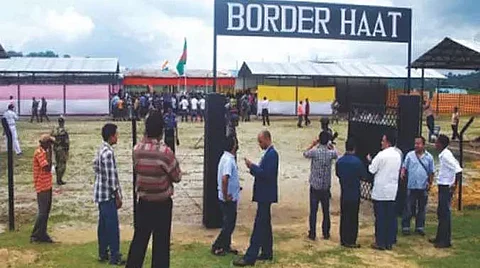
- Home
- Live Blog
- Breaking News
- Top Headlines
- Cities
- NE News
- Sentinel Media
- Sports
- Education
- Jobs

Dr. Tulika Devi
(tulika29thjan@gmail.com)
When trade meets culture and communities unite across borders, remarkable things happen. One such inspiring example is the India-Bangladesh border haats. These unique marketplaces, located precisely on the zero line between India and Bangladesh, are more than just places to shop; they are symbols of cooperation, cultural exchange, and economic empowerment.
They serve as meeting points for both Indian and Bangladeshi citizens residing in nearby areas, offering them a shared space to engage in trade, explore each other’s cultures, and build enduring friendships. It’s a microcosm of diplomacy on the ground, where the common people are the diplomats.
Key Features of Border Haats:
Tax-Free Transactions: Perhaps one of the most appealing aspects of these border haats is that all transactions are tax-free. This not only simplifies the buying process but also contributes to economic growth in both India and Bangladesh.
Dual Currency Usage: The market’s embrace of both Bangladeshi and Indian currencies promotes a sense of inclusivity and celebrates the diversity of the region. It’s a testament to the shared heritage of these neighbouring nations.
Reasonable Family Consumption: To ensure fairness and accessibility, border haats allow shoppers to purchase goods in reasonable family consumption quantities. This practice prevents large-scale commercial operations and ensures that the benefits are distributed widely among local communities.
Customs Act, 1962 Compliance: These border haats are officially recognized under the Customs Act, 1962, emphasizing their legal and economic significance. Presently, several border haats are operational, each contributing to the growth of the region’s economy and promoting cultural exchange. These include:
1. Balat (East Khasi Hills, Meghalaya): Balat is a charming border haat located in the heart of the East Khasi Hills in Meghalaya. This picturesque region is known for its lush green landscapes, rolling hills, and the vibrant Khasi culture. Balat border haat reflects the cultural richness of the area by offering acollection of traditional handicrafts, agricultural products, and local delicacies. Visitors can immerse themselves in the vibrant atmosphere of this haat while enjoying the stunning natural beauty that surrounds it.
2. Kalaichar (West Garo Hills, Meghalaya): Kalaichar Border Haat, situated in the West Garo Hills of Meghalaya, provides local residents with a unique opportunity to access goods from both India and Bangladesh. This border region is home to the Garo tribe, known for its distinct culture and traditions. Kalaichar Border Haat plays a pivotal role in preserving and promoting the Garo heritage by offering traditional Garo handicrafts, textiles, and agricultural products. It serves as a cultural exchange point where people from both sides come together to celebrate diversity.
3. Srinagar (South Tripura, Tripura): The Srinagar Border Haat in South Tripura, Tripura, exemplifies the deep economic ties between India and Bangladesh. It acts as a conduit for the exchange of goods, including agricultural produce, textiles, and electronics, facilitating commerce that benefits both nations. This haat not only boosts the local economy but also enhances the region’s overall prosperity while strengthening diplomatic relations.
4. Kamalasagar (Sipahijala, Tripura): Kamalasagar Border Haat, in the serene Sipahijala district of Tripura, stands as a model of peaceful coexistence and economic cooperation. The haat not only promotes trade but also encourages social interactions among the people of India and Bangladesh.
5. Bholaganj (East Khasi Hills, Meghalaya): Bholaganj Border Haat, located amid the lush hills of Meghalaya, is a testament to the natural beauty and economic potential of the region.The products here are not only a reflection of the region’s geological wealth but also an important source of livelihood for local communities.
6. Nalikata (South West Khasi Hills, Meghalaya): Nalikata Border Haat boasts a diverse range of goods that attract visitors from both sides of the border. It’s a place where everything from traditional handicrafts to agricultural produce can be found. The haat’s vibrant atmosphere promotes cultural exchanges, allowing people from India and Bangladesh to learn from and appreciate each other’s customs and traditions.
7. Ryngku (East Khasi Hills, Meghalaya): Ryngku Border Haat, located in the East Khasi Hills of Meghalaya, embodies the essence of cooperation between India and Bangladesh. It serves as a living example of how cross-border trade can mutually benefit both nations. Visitors here can witness the harmonious blend of cultures and enjoy a wide range of products that showcase the economic potential of this border region.
The India-Bangladesh border haats are examples of hope and collaboration. India-Bangladesh border haats are not just marketplaces; they are symbols of cooperation, economic growth, and cultural exchange. The India-Bangladesh border haats hold immense importance as they are not only economic hubs but also bridges of cultural understanding and diplomacy between the two nations. These unique markets facilitate cross-border trade, nurture economic growth, and create livelihood opportunities for local communities. Moreover, they encourage people-to-people connectivity, strengthen diplomatic relations, and preserve indigenous cultures. By formalizing trade and reducing informal activities, border haats contribute to regional stability and poverty alleviation while showcasing the shared heritage of India and Bangladesh. These markets exemplify the power of cooperation and friendship across borders, promoting harmony and prosperity in the border region.